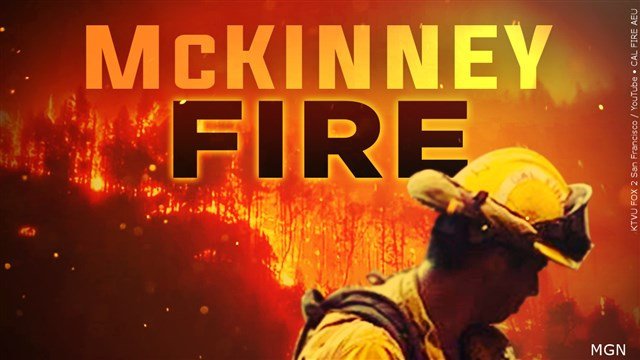Death toll in Northern California wildfire zone rises to 4

By HAVEN DALEY and CHRISTOPHER WEBER
Associated Press
KLAMATH RIVER, Calif. (AP) — Two more bodies were found within the burn zone of a huge Northern California wildfire, raising the death toll to four in the state’s largest blaze of the year, authorities said Tuesday.
Search teams discovered the additional bodies Monday at separate residences along State Route 96, one of the only roads in and out of the remote region near the state line with Oregon, the Siskiyou County Sheriff’s Office said in a statement.
“This brings the confirmed fatality number to four,” the sheriff’s statement said. “At this time there are no unaccounted for persons.” Other details were not immediately disclosed.
Sheriff’s officials said two bodies were also found found Sunday inside a charred vehicle in the driveway of a home near the tiny unincorporated community of Klamath River, which was largely destroyed in the McKinney Fire.
The fire jumped the Klamath River over the weekend and raged through the tiny community of about 200, destroying many of the homes along with the post office, community hall and other scattered businesses.
“When that fire came over that ridgeline, it had 100-foot flames for about 5 miles and the wind was blowing. It was coming down like a solid blowtorch. There was nothing to stop it,” said Roger Derry, 80, whose home was among a handful that survived.
“It’s very sad. It’s very disheartening,” said his son, whose name is spelled Rodger Derry. “Some of our oldest homes, 100-year-old homes, are gone. It’s a small community. Good people, good folks, for the most part, live here and in time will rebuild. But it’s going to take some time now.”
More than 100 homes, sheds and other buildings have burned in the McKinney Fire since it erupted last Friday. The blaze remained out of control, authorities said.
Thunderstorms dumped some much-needed rain on Monday and into Tuesday even as temperatures hit the 90s Fahrenheit (above 32.2 Celsius) and the brush, fields and forest remained generally bone-dry.
But the storms also meant a threat of lightning strikes that already sparked several small blazes and the National Weather Service issued a flash flood watch through late Tuesday night because of concerns that heavy rain could send rocks, mud and water pouring down the fire-scorched slopes.
In addition, the moisture and storms were “creating an unstable atmosphere which may make firefighting conditions much more hazardous with wind speeds potentially reaching 50 mph (80 kph) during those storms,” fire officials said.
However, the fire didn’t grow on Tuesday, and fire officials said crews were able to use bulldozers to carve firebreaks along a ridge to protect homes and buildings in the county seat of Yreka.
The Northern California wildfire has burned more than 88 square miles (228 square kilometers), and is the largest of several wildfires burning in the Klamath National Forest. A smaller fire near the tiny community of Happy Camp forced evacuations and road closures as it burned out of control Tuesday. Still more fires are raging in the Western U.S., threatening thousands of homes.
In northwestern Montana, a fire that started Friday near the town of Elmo on the Flathead Indian Reservation has burned some structures, but authorities said they didn’t immediately know if any were homes. The blaze measured 25 square miles (66 square kilometers) on Tuesday, with 10% containment, fire officials said. Some residents were forced to flee Monday as gusting afternoon winds drove the fire.
The Moose Fire in Idaho has burned more than 85 square miles (220 square km) in the Salmon-Challis National Forest while threatening homes, mining operations and fisheries near the town of Salmon. It was 23% contained Tuesday, according to the National Interagency Coordination Center.
And a wildfire raging in northwestern Nebraska led to evacuations and destroyed or damaged several homes near the small city of Gering. The Carter Canyon Fire began Saturday as two separate fires that merged. It was more than 30% contained by Tuesday.
Scientists have said climate change has made the West warmer and drier over the last three decades and will continue to make weather more extreme and wildfires more frequent and destructive. ___
This story has been updated to correct two quotes that were misattributed. The quote in the sixth paragraph is from Roger Derry, while the quote in the following paragraph is from his son, Rodger Derry.
___
Weber reported from Los Angeles. Associated Press reporters Amy Hanson in Helena, Montana; Margery Beck in Omaha, Nebraska; and Keith Ridler in Boise, Idaho, contributed to this report.